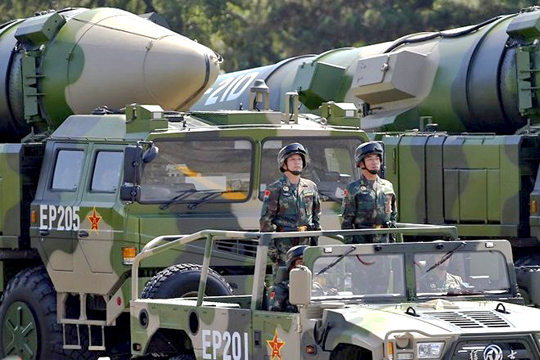Beijing, Feb 2: China has reportedly tested a new version of a missile that can carry up to 10 nuclear warheads, signalling a major shift in its nuclear capability as Beijing gears up for a possible military showdown with the US under Trump Presidency.

The flight test of the DF-5C missile was carried out last month using 10 multiple independently targetable reentry vehicles, or MIRVs, the Washington Free Beacon reported.
The test of the inert warheads was monitored closely by US intelligence agencies, said two officials familiar with reports of the missile test.
The Dongfeng-5C missile, carrying 10 dummy warheads, was launched from the Taiyuan Space Launch Centre in Shanxi province, and flew to a desert in western China, the report said.
The missile is a new variant of the DF-5, an intercontinental ballistic missile that first went into service in the early 1980's.
"The [Defence Department] routinely monitors Chinese military developments and accounts for PLA capabilities in our defence plans," Pentagon spokesman Commander Gary Ross was quoted as saying by the report.
For decades, the US has put the estimated number of warheads in China's nuclear arsenal at about 250.
But the report suggested that the latest test with 10 warheads meant the actual number could be larger.
China also began adding warheads to older DF-5 missiles in February last year, according to US intelligence agencies.
US defence officials have previously warned that China's rapid development of long-range ballistic missiles, coupled with a lack of transparency about its nuclear capabilities, could bring uncertainty to stability in the region.
The timing of the test coincided with the election of Donald Trump as US President who signalled a tougher stance against China over a range of issues, from the trade deficit to Beijing's military build-up in the disputed South China Sea.
Chinese military expert from an institute affiliated with the People's Liberation Army, (PLA) said a new test would not have been aimed at Trump.
"The test of a nuclear missile requires permission from the highest level – the Central Military Commission. It takes at least one year for the military to get the approval and to prepare for it," the Hong Kong-based South China Morning Post quoted unnamed expert as saying.
"It is not a random decision to be made just because Trump is now in office," the expert said.
Although China had made steady progress in nuclear arms development in recent years, the government had no plans to drastically adjust its nuclear policy, the expert said.





Comments
Add new comment